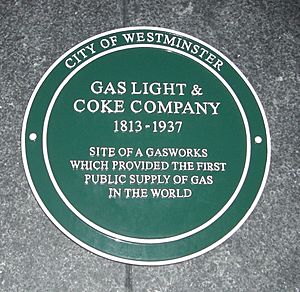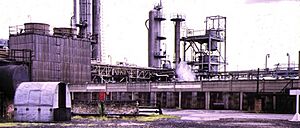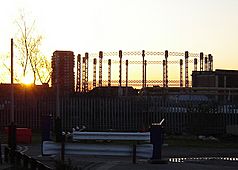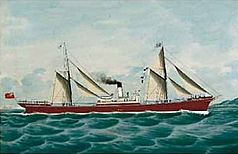Gas Light and Coke Company facts for kids

The first Watson House: a former Crosse & Blackwell factory in London that the GLCC converted into stores and laboratories in 1926. It was named after the GLCC's Chairman, Sir David Milne-Watson.
|
|
| Industry | Manufacture and distribution of coal gas |
|---|---|
| Fate | nationalised |
| Successor | Area gas boards |
| Founded | 1812 |
| Defunct | 1949 |
| Headquarters | , |
|
Number of locations
|
Beckton, Fulham, Nine Elms, Southall, Brentford, Bromley, Shoreditch, Stratford, Bow Common, Kensal Green, Southend-on-Sea, Staines, Harrow |
|
Area served
|
London north of the River Thames, Parts of Essex, Middlesex, Hertfordshire, Surrey, Berkshire, Buckinghamshire |
|
Key people
|
Frederick Albert Winsor Samuel Clegg Simon Adams Beck Sir David Milne-Watson Sir Michael Milne-Watson |
| Products | Coal gas, coke, coal tar, chemical byproducts |
|
Number of employees
|
21,250 (1948) |
The Gas Light and Coke Company (GLCC) was a very important company in London's history. It made and supplied coal gas and coke to homes and businesses. Its main office was in Westminster, London. This company is seen as the original company that later became British Gas plc.
Contents
- History of the Gas Light and Coke Company
- Gasworks: Where Gas Was Made
- Beckton Gas Works: The World's Largest
- Bow Common Gas Works
- Brentford Gas Works: One of the Oldest
- Bromley Gas Works
- Fulham Gas Works: Historic Structures
- Harrow and Stanmore Gas Works
- Kensal Green Gas Works
- Nine Elms Gas Works
- Shoreditch Gas Works
- Southall Gas Works
- Southend-on-Sea Gas Works
- Staines Gas Works
- Stratford Gas Works
- Gasworks That Closed Early
- Transport: Moving Coal and Gas
History of the Gas Light and Coke Company
The Gas Light and Coke Company was started by Frederick Albert Winsor from Germany. It officially began on April 30, 1812, with special permission from King George III. This was the first company created to supply London with gas. It also ran the first gas works in the UK, which was the world's first public gas works.
The company's leaders met for the first time in June 1812. They started with a lot of money, about £1 million (which would be around £70 million today). Their offices were in Pall Mall. By 1818, they had expanded their operations. Samuel Clegg, the company's chief engineer, helped a lot. By 1819, they had laid almost 290 miles of pipes across London. These pipes supplied gas to 51,000 gas burners. Clegg also invented a useful gas meter.
Over the years, the GLCC grew by buying many smaller gas companies. This helped them serve more areas and more people. Some of the companies they took over included the City of London Gas Light and Coke Company and the Imperial Gas Light and Coke Company.
As electricity became popular, the GLCC started offering services for homes. They even hired "lady demonstrators" to show people how to use gas for cooking. This service later became a full advice center for using gas at home.
By 1948, the GLCC supplied gas to a huge area of 547 square miles. This included parts of London, Essex, Middlesex, Hertfordshire, Surrey, and Berkshire. They served 4.5 million people and had over 21,000 employees. In 1949, the company became part of the government's plan to control gas supply. It joined the new North Thames Gas Board.
Even today, you can sometimes see old GLCC service valve covers on the streets of London. They are a reminder of the company's long history.
Gasworks: Where Gas Was Made
When the GLCC became part of the government in 1949, they had thirteen large gasworks still operating. These were the factories where coal was turned into gas.
Beckton Gas Works: The World's Largest
Beckton Gas Works were built in 1868 in East London. They were named "Beckton" after the company's chairman, Simon Adams Beck. This huge site, covering 550 acres, allowed the GLCC to make much more gas. It was also located by the river, so large ships could bring in coal easily.
In 1872, some workers at Beckton went on strike for better pay. They were put in prison for a short time, but their sentences were later reduced. This event helped lead to the creation of the National Union of Gasworkers and General Labourers.
By 1949, Beckton was the biggest gas works in the world. It could produce over 119 million cubic feet of gas every day! The works finally closed in 1976.
Bow Common Gas Works
The Bow Common gasworks was built in 1850. It was later taken over by the GLCC in 1870. The GLCC completely rebuilt the works in the early 1930s. By 1948, it could produce over 10 million cubic feet of gas daily.
Brentford Gas Works: One of the Oldest
The Brentford Gas Company started in 1820, making its gasworks one of the oldest in the country. It supplied gas to many towns like Acton and Ealing. Even though a new works was built in Southall, the Brentford site kept operating. It was rebuilt in 1935 and could produce over 15 million cubic feet of gas per day by 1948.
Bromley Gas Works
The Imperial Gas Light and Coke Company built the Bromley works. It became part of the GLCC in 1876. The plant was rebuilt in the 1890s. By 1948, it could produce over 30 million cubic feet of gas daily. The site closed in 1976, but its large Bromley-by-Bow gasholders are still there and are protected as historic buildings.
Fulham Gas Works: Historic Structures
The Imperial Gas Company began building its works in Fulham in 1824. Its number 2 gasholder, built in 1830, is thought to be the oldest gasholder in the world! The old office building and a laboratory at Fulham are also historic and protected.
Coal was brought to Fulham by special ships called "flatiron colliers." These ships had low tops so they could pass under bridges. By 1948, the Fulham works could produce over 32 million cubic feet of gas daily.
Harrow and Stanmore Gas Works
The Harrow and Stanmore Gas Company ran gasworks in Harrow and Stanmore. The GLCC took them over in 1924. A new type of gasometer was built in Stanmore in 1931. It was painted with wavy green lines to help it blend in with the landscape. By 1948, the works could produce over 3 million cubic feet of gas daily. The gasometer was taken down in 1986.
Kensal Green Gas Works
The Kensal Green gasworks was built in 1844. It first supplied a special type of gas that gave a brighter light. The GLCC took over the company in 1873. The Kensal Green works were completely rebuilt in the early 1930s. By 1948, it could produce over 16 million cubic feet of gas daily.
Nine Elms Gas Works
Nine Elms Gas Works were built in 1858 on the south bank of the River Thames. The GLCC took over this company in 1883. The works covered 20 acres and once employed 800 people. There was a big explosion there in 1865, which sadly killed eleven workers.
Coal was brought in by special ships. By 1948, the works could produce over 27 million cubic feet of gas daily. Nine Elms Gas Works closed in 1970 when Britain switched to natural gas from the North Sea.
Shoreditch Gas Works
The Shoreditch gasworks was another project by the Imperial Gas Light and Coke Company, built in 1822. It became part of the GLCC in 1876. By 1934, Shoreditch was used as a backup station, only operating when there was very high demand for gas. In 1948, it could produce over 5 million cubic feet of gas daily.
Southall Gas Works
Southall Gas Works was finished in 1869. The GLCC took over the company in 1926. Southall's No. 5 gas holder, built in the early 1930s, is over 300 feet tall and is still a well-known local landmark.
Coal arrived at Southall by canal and railway. Like Beckton, Southall was a big producer of road tar. By 1948, it could produce over 20 million cubic feet of gas daily.
Southend-on-Sea Gas Works
The Southend-on-Sea and District Gas Company started in 1854. The GLCC took them over in 1932. The gasworks in Southend was old, so it was completely rebuilt. Coal was brought in by ships to a special pier. By 1948, it could produce over 7 million cubic feet of gas daily.
Staines Gas Works
The Staines gasworks was built next to the River Thames. The GLCC took over this company in 1926. Even though it was a small works, it was kept because it could meet the gas needs of the local area. A new type of gasometer was installed in the 1930s. By 1948, it could produce over 1 million cubic feet of gas daily.
Stratford Gas Works
The gasworks at Stratford was built by the West Ham Gas Company. It supplied gas to a busy area east of London. The GLCC took it over in 1912. By 1948, it could produce 9 million cubic feet of gas daily.
Gasworks That Closed Early
Many smaller gasworks that were part of the GLCC or the companies it bought closed down over the years. This happened as the company grew and built larger, more efficient gasworks. Some of these included Aldgate (closed 1823), Brick Lane (closed 1871), and Richmond (closed 1933).
Transport: Moving Coal and Gas
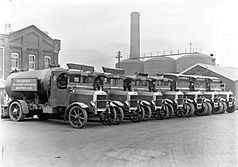
The Gas Light and Coke Company had a huge transport system. This included ships, barges, railway wagons, and even horses and later trucks. They used these to bring coal to the gasworks and to take away products like coke and other chemicals. They also used them for local deliveries and maintenance.
GLCC Ships
The GLCC had its own fleet of ships, mostly "colliers" which carried coal. These ships had a special look: brown tops, black funnels with silver bands and red pyramids. Their flag was white with a red sun and the letters "G L C Co."
Here are some examples of their ships:
- SS Lanterna (built 1882): Sank in 1916 by a mine, but all crew survived.
- SS Coalgas (built 1890): Sank in 1918 by a mine, all crew survived.
- SS Ignis (built 1903): Sank in 1915 by a mine, all crew survived.
- SS Fulgens (built 1912): Sank in 1915 by a German submarine, all crew survived.
- SS Lampada (built 1889, bought 1915): Sank in 1917 by a German submarine, five crew members were killed.
- SS Capitol (I) (built 1906, bought 1915): Sold in 1925 and used until 1957.
- SS Phare (built 1906, bought 1915): Sank in 1917 by a German submarine, 14 of 18 crew were killed.
- SS Ardens (built 1878, bought 1916): Sank in 1917 by a German submarine, one crew member was killed.
- SS Lanthorn (built 1889, bought 1916): Sank in 1917 after being attacked by a German submarine.
- SS Firelight (built 1896, bought 1916): Sank in 1917 by a German submarine.
- SS Glow (built 1900, bought 1916): Sank in 1917 by a German submarine, one gunner was killed.
- SS Halo (built 1919): Sank in 1941 by a mine, salvaged, then sank again in 1945 by a German E-boat. All crew were saved the second time.
- SS Whitemantle (built 1920): Sank in 1939 by a mine.
- SS Flashlight (built 1920): Sank in 1941 by enemy aircraft.
- SS Gaslight (built 1920): Used until the company was nationalized in 1949.
- SS Fireglow (I) (built 1925): Sank in 1941 by a German mine, one crew member killed.
- SS Homefire (built 1925).
- SS Lady Olga (built 1927): Used until nationalization in 1949.
- MV Barking (built 1928): A tugboat that still exists today and is preserved.
- SS Suntrap (built 1929): Used until nationalization in 1949, then sold.
- SS Torchbearer (built 1929): Sank in 1939 by a mine, four crew members killed.
- SS Horseferry (built 1930): Sank in 1942 by a German E-boat, 11 crew members killed.
- SS Mr. Therm (launched 1936): Named after a famous advertising character for the GLCC.
- SS Icemaid (launched 1936): Used until nationalization in 1949, then sold.
- SS Gasfire (launched 1936): Damaged by a German E-boat in 1940, rebuilt, then sank in 1941 by a mine.
- SS Murdoch (launched 1941): Sank in 1941 after hitting a submerged wreck.
- SS Capitol (II) (launched 1941).
- SS Adams Beck (built 1941): Sank in 1941 after being attacked by enemy aircraft, one crew member killed.
- SS Fireside (launched 1942).
- SS Flamma (launched 1942): Used until nationalization in 1949, then sold.
- SS Firedog (launched 1942).
- SS Winsor (launched 1942): Used until nationalization in 1949, then sold and later wrecked.
- SS Firelight (II) (launched 1943): Torpedoed in 1943, lost its front part, but was repaired and returned to service.
- SS Fireglow (II) (launched 1944): Took the name of an earlier ship that sank.
- SS Firebeam (launched 1945).
- MV Adams Beck (launched 1948): Took the name of an earlier ship that sank. Used until nationalization in 1949, then sold and later ran aground.


